This is more of a "how can
I?" than a "what is it?" but I would really appreciate any
help you might be able to give me.
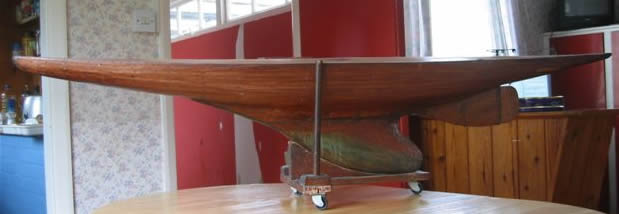
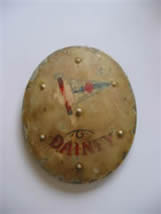
I bought this boat on the spur of the moment about a
year ago from a guy who lives in Wimbledon, and I am just about to start restoring
her, this is what I do know
She is called "Dainty" and is a 10 Rater with
a LOA of 63" and a Beam of 12", the guy I bought her from said that
his Grandad had built her and had seen somewhere (still looking for it!) a
picture of her and his Grandad on Clapham Long Pond or Clapham Common pond
in the early 30's but he was sure that the boat was built much earlier than
that. Apparently after an outing on a windy Sunday morning in the mid 30's,
Grandad bought her home with a mast broken in half and laid her to rest in
his attic which is where she had been up until last year. I assume she was
built from a kit due to the 1 and 2 set sail numbering and the set markings
on the boom, but I'm not certain and luckily she remains pretty much in one
piece with all the bits I need to restore her but the questions that have
been raised are this
Which sail plan should I restore her to?
Although obviously Bermudan rigged before she was tucked up in the attic,
there is evidence of a bowsprit being fitted at some point and a spar of some
description that looks dangerously like one in a box full of bits that came
with her. Also in the tangle of bits that came with the Bermudan rig were
2 small sails (pictured) with 2 spars attached, what are these for?
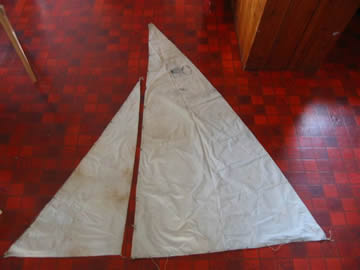
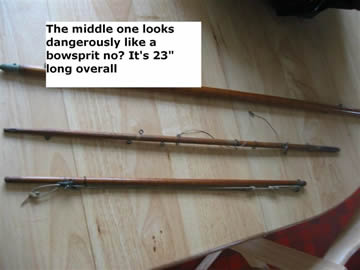
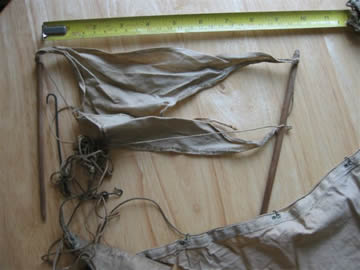
I don't want to overdo the restoration but should I replace,
or repair the deck? It has a split probably about 10" long?
I think that's most of my questions for now, apart from
do you have any contacts in East Anglia for sail makers and someone who repairs
masts? Thanks for taking the time to read this, this is my first of many vintage
yacht restorations so any help or tips would be most appreciated.
Comment from Russell Potts
You probably did not realise
is that the sail numbers enable us to establish from the old register that
the boat is indeed 'Dainty', originally 'Dainty Too'. She was originally owned,
designed and built by W Kingsmill of the Forest Gate club in E London. She
was first recorded in 1925, but may have been built earlier, because she is
in those pages that were filled in, in one go, when the existing register
book was opened. She was re registered at least twice up to June 1939 and
changed hands a couple of times to an L E Carpenter and someone else, possibly
M Apling, all within the FG club. It's very hard to disentangle as entries
have been crossed out and overwritten.
Though bermuda rigged at present, it is very likely that she was gaff rigged
originally, as nearly all 10-raters were before 1930. The 'extra' sails may
well be the headsails from the gaff rigs, which were kept because they might
come in handy. Under gaff rig she would have had a short bowsprit. Look for
evidence of screw holes from the deck fittings to take it, but I don't think
that the spar you mention is a bowsprit. More likely a boom from an earlier
rig.
I would be inclined to leave the boat in her Bermuda rig. The sails are the
genuine article, the second suit appears to be in goodish condition and could
probably be used. The top suit may well be more than she can carry in anything
more than a whisper. I should be inclined to try her with the second suit
before deciding to have a replacement top suit made. What is the area of the
top suit? what is the displacement? This will help to decide whether it is
sensible to start with a second suit rig. If you want to go back to the gaff
rig, have a look at the LSA Rule page of the VG web site, where the sail plan
for XPDNC gives the style of rig that was almost universal for the class from
about 1906 to the late 1920s. Notice that the bowsprit is quite small. In
the example that I have, the second suit jib tacks very slightly inboard of
the stem.
I would be inclined to make a new mast rather than try to mend the old one.
It's easy if you start with a square piece. Plane in the taper on the front
and sides, not on the back edge, which you want to keep straight. Take off
the corners to give an octagon, then again for 16 sides, then sand off the
corners. On the other hand a clean break, or a 'greenstick' fracture that
can be coaxed back into alignment should mend with epoxy glue and be amply
strong enough.
Decks are the most vulnerable part of the boat. The biggest single piece,
usually the thinnest and often the worst quality wood. Picture backing was
often used as a ready source of thin pine in the necessary width. Not properly
seasoned, when it dries and shrinks over 50 years away from the water, it
splits. If the split is not too wide it can be backed underneath with thin
ply. Use strings fed down through the split to hold them up while the glue
goes off. The resulting slots can then be filled either with slips of wood
or with some sort of filler gunge.
On the other hand, if you need to take the deck off, for instance to line
the planking with cloth varnished on to make good plank shrinkage, you should
be able to do a better job on the splits. A replacement deck would have to
be made of ply nowadays, as picture framers all use hardboard to back their
frames now.
Sailmakers in cotton are not thick on the ground Among our members Brian Wiles
in Somerset does cotton sails, though I haven't seen them. Our ex-member Ralph
Nellist in Lincoln does a good job. He is in Lincoln. If you want details
of their addresses etc, email me direct. Ralph wrote a very good book on how
to do it for yourself, which I can supply. I can also supply Jack's Guide
to Restoration. Or I can in a few weeks as it is currently reprinting.
If you have a series of boats to restore, you should join the VG. We all want
to see Dainty on the water.
| 